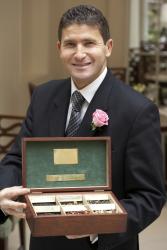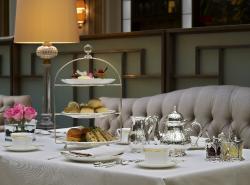 Amidst The Lanesborough Hotel’s service bells and cake carousels, Douglas Blyde meets self-titled ‘Tea Sommelier’, Karl Kessab. The glamorous conservatory currently holds the UK Tea Council’s ‘Award of Excellence’, and regularly achieves London’s ‘Top Afternoon Tea’.
Amidst The Lanesborough Hotel’s service bells and cake carousels, Douglas Blyde meets self-titled ‘Tea Sommelier’, Karl Kessab. The glamorous conservatory currently holds the UK Tea Council’s ‘Award of Excellence’, and regularly achieves London’s ‘Top Afternoon Tea’.
Where did afternoon tea originate?
Feeling peckish between lunch and dinner, Anna Maria Russell, 7th Duchess of Bedford, asked her butler for small cakes and delicate sandwiches to accompany her tea. On inviting friends to share the ceremony, it soon became fashionable. Fast forward 200-years, and we’ve refined Russell’s ritual. I’ve made the pilgrimage to Woburn Abbey, where it all began.
Is it strange that a non-Brit has become famous for rejuvenating a British tradition?
It’s ironic, but flattering. Whilst I grew-up in Algiers, where tea is an inherent part of the culture, I actually refined my interest in the UK, working and attending workshops with the Tea Council, who are based in Fulham. I’m indebted to the British who are the best brokers bringing in the finest teas. It all happens here.
What do the UK Tea Council look for when assessing London’s Top Afternoon Tea?
They judge 16 categories covering opulent surroundings, consummate knowledge, a comprehensive tea carte with great core teas, and fastidious tea etiquette. As you might imagine, there is rigorous competition between London’s top hotels.
Can you spot an inspector?
To an extent, especially when they ask specific questions, although it is harder to spot incognito ‘couples’ who book on a busy Saturday. They try to get you one way or another over two-to-three visits. The winner is formally presented with a vase by artist, Adam Aronson in March. We’ve running out of room on our display.
Do you see yourself as a tea doctor?
I can truly guide people, helping them match up to four teas a sitting with their food, as well as informing them about the history of a style. Tea and food pairing is becoming increasingly in vogue. I marry Earl Grey with chocolate and white with seafood. Black, inevitably, works with a hearty breakfast. Working closely with Tal Hausen, our pastry chef, we’re imaginatively reinventing menus and delicately infusing tea cakes with tea leaves.
Are modern sippers more savvy?
They’re more inquisitive about tea’s complexities as well as its health benefits, which is perhaps why green tea seems to be selling so well. I’ve enjoyed forging relationships with guests who approach me as an expert, bringing samples of Rooibos from South Africa, or telling me about holidays spent amongst Darjeeling’s tea gardens. The latter were surprised when I explained that to satisfy demand, up to 90p/c of Darjeeling plants grow in Nepal rather than West Bengal.
Are your teas available elsewhere?
Judging by the daily e-mails, a lot of people want to buy my blends, which have become brands. But my list is unique – I’ll attend auctions and buy whole shipments in my quest to refine it, so our teas are only available from The Lanesborough.
How is your signature afternoon blend devised?
I’ve built the base with delicate, fragrant Darjeeling from the ‘Doumurdullong’ tea garden. This is mashed with Chinese ‘Keemum’ and fired over rose petals, which achieves balance. Being a versatile blend, guests may add milk or enjoy it black. Due to its cleansing acidity, it never sits on the palate.
Do you prefer putting milk in first?
Afterwards – or not at all – as more guests than ever are willing to try.
Has anyone read your tea leaves?
I’m not superstitious, although I can tell the ‘terroir’ in which the tea was grown by peering at the dregs.
Are you interested in applying tea tasting techniques to other things?
I’ve taken part in water tastings, successfully distinguishing sources. As a result, ‘Braun’ tried to persuade me to put my name to their kettle.
Do different teas require different temperatures?
Absolutely, which we achieve through a range of kettles and Russian Samovar’s. For example, black is best between 87-90 degrees, whilst our handpicked white from Doomurdullung, of which only 2kg was produced this year, blossoms at 83-85. We also have iced teas and outstanding aged options.
Are you surprised by the interest you generate?
It’s amazing! A Google search yields pages of results. Following a feature for a German magazine, I noted a lot of German guests asking me, ‘was that you in the picture?’ I grabbed a niche, capitalising on Britain’s unexploited bounty, communicating the sheer range available. Being good at what I do also helps.
Do you ever see your speciality as trivial in a chaotic world?
I never take politics to tea. My aim is simply to make sure people enjoy what they drink.
How much do you drink?
Less than a cup a day, believe it or not. I tend not to sit around sipping tea all-day, but constantly taste.
How do you cleanse your palate?
By drinking up to four gallons of filtered water a day, and plenty of mint tea. I also keep fit, running in the afternoons, and playing polo on days off.
How long is your day?
Between 12-14 hours. At The Lanesborough, we’re perceived as setting the standard, so I often continue blending and research at home in Surbiton.
How many teas are on your list?
56, although I am able to craft something else to suit a guest’s mood. ‘Sit tight,’ I’ll say, then play, shuffling some leaves and apply the magic touch. Whilst I never disclose a formula, I keep meticulous notes to keep track of trends.
Where is the best afternoon tea outside England?
Despite a relatively small collection, the afternoon tea at La Gallerie, Hotel ‘Georges V’, Paris is fabulous, with fresh cakes and pristine etiquette such as changing the cup after the third pour and exchanging the leaves. Conversely, I’ve suffered establishments where they’ve insisted that Lapsang-Souchong was Darjeeling.
How is your signature afternoon blend devised?
I’ve built the base with delicate, fragrant Darjeeling from the ‘Doumurdullong’ tea garden. This is mashed with Chinese ‘Keemum’ and fired over rose petals, which achieves balance. Being a versatile blend, guests may add milk or enjoy it black. Due to its cleansing acidity, it never sits on the palate.
You were the first, but where would we find other tea sommeliers?
New York.
What are the oddest tea-related questions you’ve heard?
‘Will tea make me look younger, reduce cholestoral, or enhance my libido?’ I advise those asking to observe China, a tea culture who live long, healthy lives.
How might climate change affect your passion?
Fortunately, tea is one of the more resistant plants, particularly black tea. The biggest threat is fire.
Will we ever sew tea in the UK?
We already do in Devon and Cornwall, although I don’t generally rate it.
What are your thoughts on ‘Starbucks’ et al?
Coffee has become a must-have in big cities. It’s seen as the networking drink, although I’ve seen an increase in people doing business over ‘power teas’. Whilst I like coffee, it’s worth noting that tea outsells it by three cups to one worldwide. What was once seen as a drink for the elderly is increasingly of interest to a new generation. If demand wasn’t there, why would Starbucks offer their own tea collection? In my opinion, tea’s becoming the new coffee…
What’s brewing?
I’d love to own a nice tea place of my own one day, most likely in the UK, where I could continue to work closely with rare teas.
Afternoon tea costs from £35 and commences 4pm, 4.30pm and 5pm daily
Gluten and dairy-free options are available with 12-hours notice
www.lanesborough.com – Hyde Park Corner, London. SW1X 7TA

